Smithology: Secrets of the Supra that broke (wore out, actually) the mold
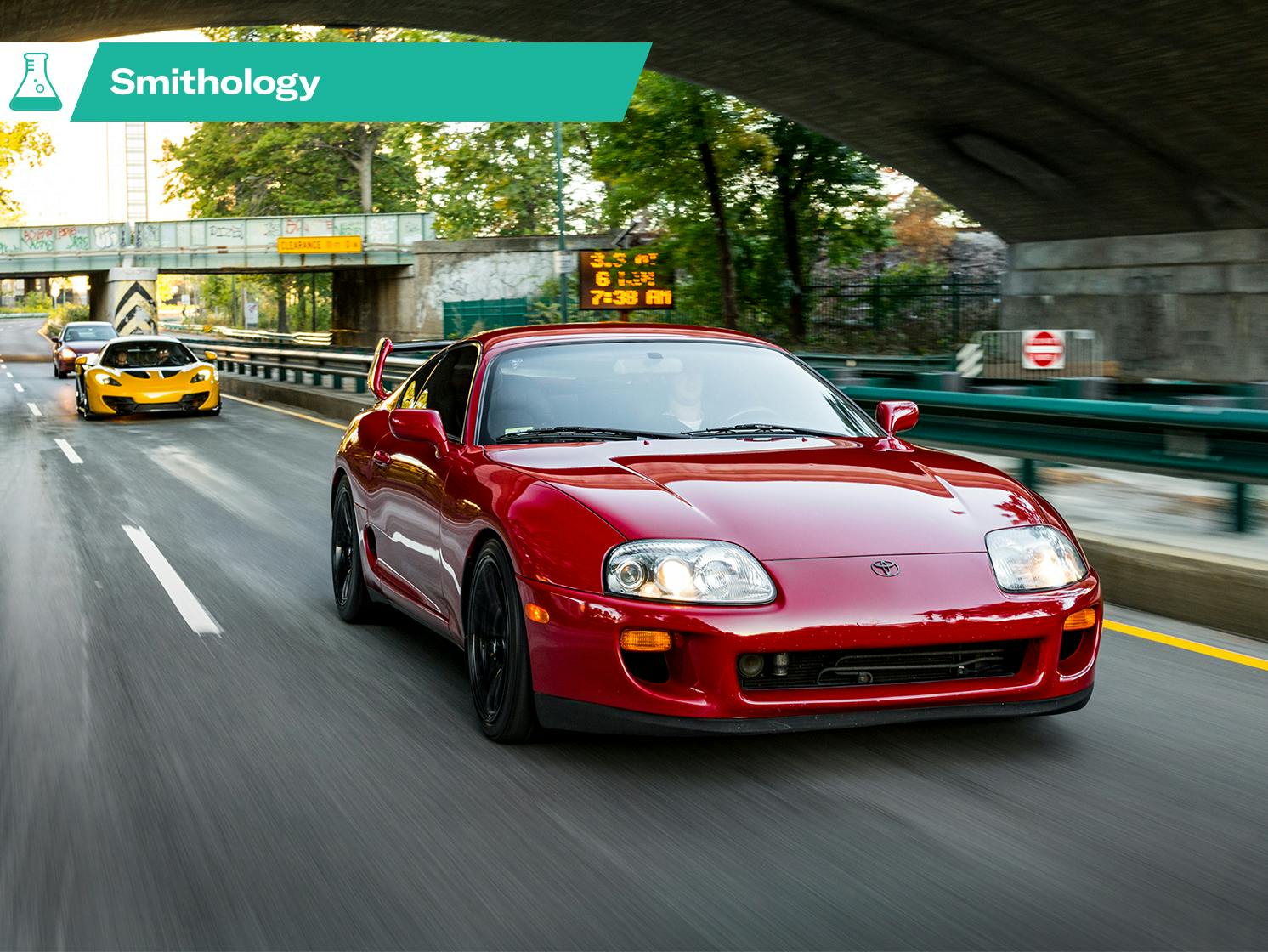
The first thing you learn when you talk to the Mark 4 Turbo Supra man is that there is no Mark 4 Turbo Supra man.
I mean, there is, of course. He exists. But I can’t tell you his name, because he works for Toyota’s North American office in a technical capacity, and is typically not permitted to speak to the press. So I called him. We spent almost an hour discussing one of the most famous fast cars ever built, including what it takes to blow one up.
By way of background, I was recently embroiled in a research project on the A80-chassis Toyota Supra Turbo. You may know this car as the 1993–1998 Toyota Supra Turbo, or perhaps the Mark 4 Turbo Supra, or maybe The Supra Containing Toyota’s Landmark 2JZ Straight Six. There is a chance you simply remember the car as the Supra from the Fast and Furious films, a performance-art/documentary series where logic takes a back seat to controlled explosions and the fine craft of yelling at a steering wheel. (STAR MOVIE CARS, THEY ARE JUST LIKE US, especially when they’re, say, a Lamborghini being harpooned in the door while racing Charlize Theron’s submarine across Russian sea ice. Cinematic achievement.)
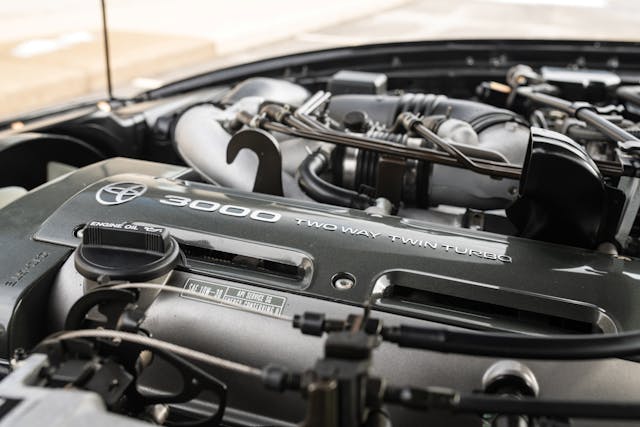
In most circles, “Mark 4 Supra” is verbal shorthand for stone-axe power. The 2JZ is essentially Japan’s Chevy small-block, one of the most durable and potent cannons to ever crawl out of the human brain’s primordial creative ooze. Standout qualities include ferocious breathing ability, notably smooth power delivery, and a bottom end stout as a mountain. When turbocharged—a condition the 2J likes very much—this twin-cam device becomes something else: epic in deed and song, subject of myth and legend, a Beowulfian titan in tuner-car story circles, the unmasked singer at the root of a million internet-forum arguments and half the SEMA builds in history.
The American market saw a factory-built turbo 2J only in the A80. In our showrooms, it was available with twin sequential turbos and 320 hp. Later, to paraphrase Monty Python, the world discovered that a large single turbo could lead to four-digit ponies and more durable light than a small sun, and there was much rejoicing.
Who doesn’t love the mythology of engines, the engines of mythology? Me, I heard a highly entertaining and forthright man from Toyota’s tech department say the words “taco the rods” in close temporal proximity to the phrase “2500 horsepower on a factory crank,” and I decided that this conversation needed a public home. The following transcript represents a good dose of trivia for an inarguably rising star in collector-car circles and one of the coolest kaiju to escape Japan.
Enjoy.
**
Sam Smith: Let’s say you fell from another planet five minutes ago and know absolutely nothing about the Mark 4 Supra. Thirty seconds on Google would tell you that the cars get modded. About the power.
Mk. 4 Inside Man: At this point, if you’re talking completely untouched cars, stock—that’s probably less than 15 to 20 percent of what’s left. That’s cars still running on stock twins [turbos] and stuff. There are probably more in California than anywhere else, just because of smog regulations and so on.
SS: There’s this idea—this thing with Supras, called the BPU, or Basic Performance Upgrade. The idea that the cars work really well with a short list of mods that have, over the years, become almost de rigueur.
M4IM: That is true—the BPU, the idea that they’re best when lightly modified. But there has been a resurgence with original cars. The pendulum has kind of swung back the other way. People either have their cars all stock, or pretty well modified. Most of the modifications are pretty basic—lightly breathed on, a downpipe and exhaust, take the catalytic converters off, change the intake system, remove the [mass-airflow sensor] and just having the straight pipe there. Just having a mass-airflow converter, you can get 450 hp out of the stock turbos pretty easily.
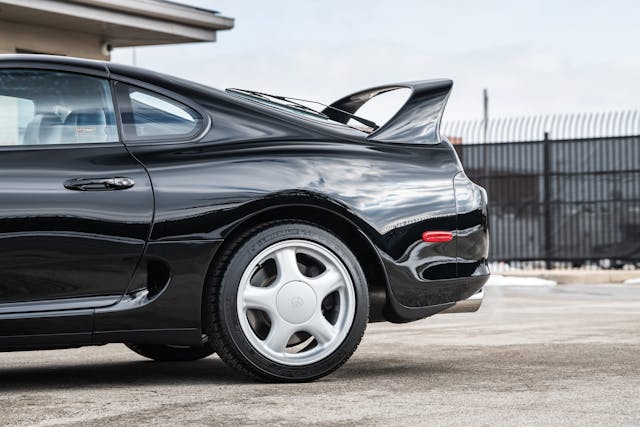
SS: Let’s say you don’t want enough power to liquify pavement, for some reason. You don’t want one big single turbocharger, like most people run now, you want the factory twin setup. Is there any reason why you wouldn’t keep the stock sequential turbos?
M4IM: At this point, the biggest problem with the stock twins is that they start getting unreliable. The most common, the biggest super-caution is that the secondary turbo starts to make noise. When you accelerate, you get to 4000 rpm, if you start to hear a bit of a whining or grinding noise, that’s the rear turbocharger starting to fail. The forward turbo, the front turbo, is the primary, constantly operating. There’s an exhaust-gas control valve and an intake air-control valve that actually blocks the exhaust outlet and the compressor outlet on the rear turbo from functioning, so all exhaust energy goes through the front turbo.
When the car goes into sequential—when the second turbo comes active—it’s an airflow-value-based thing, 3800-4000 rpm. When you make higher boost levels, you have to put everything through the front turbo. When it switches to the rear turbo … [if the rear has failed], the car may lay over a little bit. It will pull aggressively to 3800 and then fall on its face. If that happens, that means the second turbo is gone.
SS: What tends to go in it?
M4IM: The turbos are super responsive because they have really small compressor and turbine wheels. But the big thing is that the quill, the turbine shaft, is very small in diameter, so any slight imbalance bends the quill. The whining you hear is the turbo compressor wheel beginning to impact the compressor housing.
Other than that, it’s the usual things: watch for smoke on startup, got whole bunch of hot turbo components, things dry out, etc. Look at wiring harness very common for coil wires to need to be replaced, ones that feed the coils. Cam sensor connectors up against cylinder head, dry out and break wires off. Everything sits there for a long time and it gets dried, you move it to change something breaks, you know.
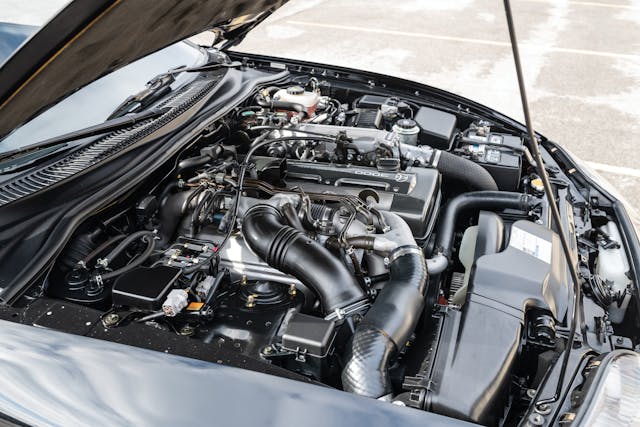
SS: The cars were so heavily modified in period, but that was a long time ago—do you still see sketchy home-brew mods on survivors? Anything in particular to look for?
M4IM: People wound up cutting into the wiring harness in the day, to do stuff. To add the MAF eliminator and things like that. A boost converter is the number-one thing, modifying the MAF signal so that high boost doesn’t cut off, shut off boost. A lot of the hoses are severely dried out from heat. A lot of that stuff, guys replace with silicone hoses, or use aftermarket couplings, so it’s not impossible to maintain or keep going. Again, the biggest problem is age and turbochargers leaking, seals go out the window.
SS: What do most people chase when they’re in the market?
M4IM: Well, the hardtop six-speed [manual] car is the hail Mary—what everyone wants. There’s a noticeable rigidity difference between hardtops and targas, though the targa is still a pretty rigid chassis. And automatics don’t command as much value by a long shot.
The land mine is, is it a naturally aspirated car that someone converted to turbo, or changed out? There really wasn’t too much difference in chassis—the brake system is much larger on the turbo car, but a lot of people change that stuff. That’s the only catch, if it was originally a turbo car, but most people don’t care. A lot of it is how the people who grew up wanting one now have the money to buy one, and they want what they grew up with, the idea.

SS: What should you look out for, generally?
M4IM: If you want a Supra, you’re looking for the body of the car; you can change a lot of the rest. If you want to build up a crazy car, buy a naturally aspirated car—you can change engines, swap on a VVTi head, and at that point, who cares what you start with? The market is surprisingly forgiving for mods and how the cars work.
The main things to watch for are filled panels and stuff like that, from crash damage. Use a paint-thickness gauge. A lot of these cars have been run hard. There aren’t too many places on a Mark 4 that rust particularly badly—people have long had enough respect for them to not use them like that [in winter and salt].
Look at all the soft parts—seals and so on. The big problem [with the current market] is overvalued s*** cars—it doesn’t matter if it’s all original if all the original parts are garbage. It’s becoming increasingly difficult to find certain parts. Dash panels cost you $4000 for a full set, you can’t buy quarter windows, there are no reproduction trim bits or seals, interior panels, nothing. Edge moldings, rear-window glass, stuff like that.
People are trying to do that stuff now, but the interior still dictates the car. It was fashionable in the day to cut the dash out, put in gauges, throw turbo timers and stuff into the dash, things that don’t get used any more. It’s very common to see rust in the rear, even just from washing—the lower quarter collects water, rusts out around the glass. It starts below the trim, and if you don’t blow it out, it sits and collects, eventually rots.
All that said, they hold up pretty well. You have to remember, this was the heyday of Toyota, back in the early Nineties, the yen to dollar favorable, the company was spending money, there was no lack of putting enough EPT coat on stuff when it was built.
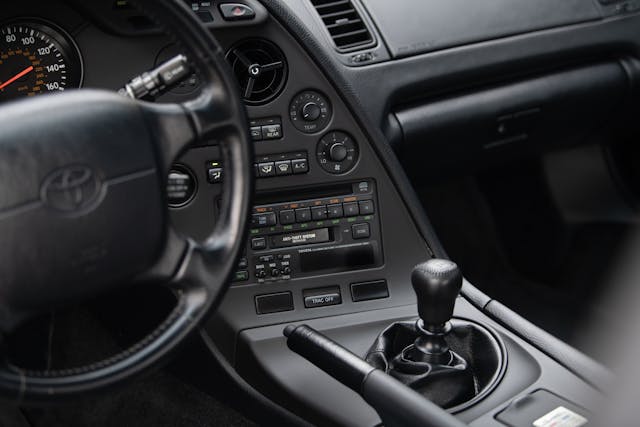
SS: That durability—a lot of cars must have seen an awful lot of abuse.
M4IM: The automatics are durable to a point—there have been some tremendous advances, there’s a dude running sevens [in the quarter-mile] on that trans in Florida—but a lot of it is torque management with engine control. Depending on how much power you’re making, not going into overdrive in a race, for example. They’re pretty strong—the input shaft is one of the weaker points. The weakest point is second-gear sprag; you spin the tires in second gear, then it bites under power and just rolls the sprag, it’s not very big. There’s a kit to swap in a GM Turbomatic, things like that.
But as long as you don’t do anything stupid like rev it up and drop it into gear? A lot of it is just good engine management.
SS: The cars were famous for making 1000 hp, back when that number was just massive for a six-cylinder road car. That’s now become common, right?
M4IM: These days, the limit has gone through the absolute roof with boost and power—the car can take it. There are hundreds of 1000-plus-hp Supras out there. That was the thing that made the Mark 4–it was never really a particularly awesome handling or braking car. Its reputation came from its toughness. The car was strong, you could keep leaning on it.
Over time, turbo tech changed a lot with regard to power and drivability, what kind of power you make. Guys would make 800 horse on a stock engine with an older-style turbo that came on late and didn’t make tremendous torque. Newer turbos, relatively small, come on so strong. It’s not uncommon for a 2J with a 64-mm turbo to make 800 lb-ft at 5000 rpm and 925 hp with a [Chevy] LS-style power curve. Then you have to start paying attention to other things. When you make that much power down low, you start to taco the rods and stuff.
SS: The image on those words is just … so great.
M4IM: Generally speaking, even a set of inexpensive steel rods and pistons with factory mains, it’s all-the-time good for 1000 hp. Past that, 1100 or so, you have steel mains, you have to start part-filling the block.
SS: This is broad, so forgive me, but in the big picture, what shouldn’t you do with a modded car, if you want it to live for a bit?
M4IM: The diff is strong, the gearset itself is tough as nails, but the Torsen limited-slip—it can’t handle shock loads, wheel hop or axle tramp will shatter the rear end. The TRD [Toyota Racing Development] diffs are good but long since gone. A Giken [aftermarket LSD] is worth having, though.
Drag racing will twist the driveshaft like a drill bit, but the factory driveshaft is usually fine for most of what you’re going to do with it. The six-speed car has a lot of stuff with clutches, the automatic car is a lot easier on parts. People swap six-speeds into automatics, but the six-speed problem is that parts for the swap now go for $10,000. People make T56 adapter kits, or a Nissan G37 transmission goes in as well.
Pay close attention to how the trans shifts if you buy a six-speed car. Synchros and stuff are available, and you can throw rocks in that old transmission and you won’t hurt it. The manual’s output shaft is over an inch in diameter. But if you damage the teeth on the synchros, it may be damn near impossible to fix. A lot of shops, the (stock six-speed Getrag) V160, they won’t touch them any more because they can’t get parts.
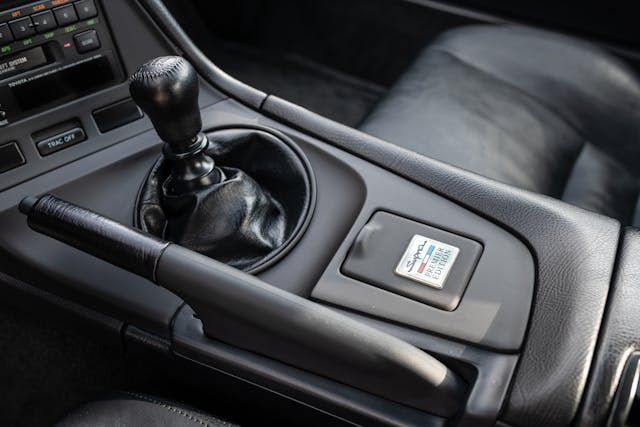
SS: Ten grand can seem like a lot, but when you think about the numbers, how orders were split across manual/automatic, it makes sense.
M4IM: There are just only so many of them, and there’s a demand. People don’t realize just how rare the Mark 4 really is—these cars were made in the low thousands, and not just turbos.
SS: A lot of folks are at the point where they grew up with the cars and can finally afford one. What’s the one piece of advice you’d give to someone looking, after years of wanting?
M4IM: Have realistic goals. A lot of people went big with turbos and make the power, but it’s no fun to drive. So many people want the 1000-hp Supra because it’s not terribly hard to make, but it’s expensive—you break a differential, good luck finding one. Keep your power goals reasonable, you don’t have to go super extravagant on parts, or run the risk of damaging things.
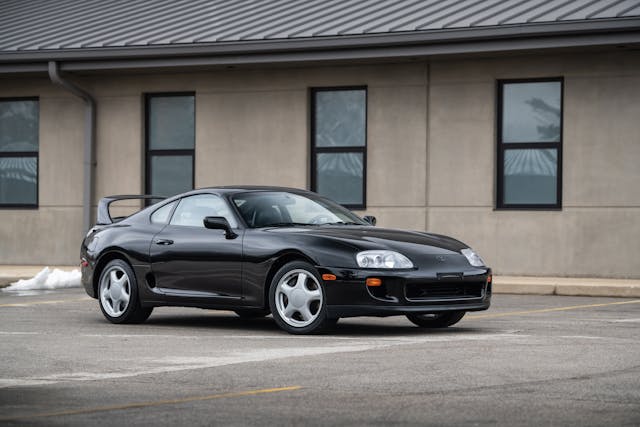
SS: As it is with anything: Think about what you want to do with the car, and aim for it, not just random changes.
M4IM: Goes back to what I said earlier: To get the tires to hook up, to get the traction, people take the turbo brakes off and put on the smaller n/a brakes—in that case, why the hell did you buy the turbo car? Take the stuff off that makes the the turbo, the turbo? It’s the old line: Don’t own it, clone it.
SS: Makes sense, especially given the recent rise in prices. Must be nice to see the car being appreciated.
M4IM: I’ll tell you a story: Toyota stopped making 2JZ cylinder heads a while back because the molds wore out. The company sells 30 of those things a month, even now, and demand never slowed down, not since the car was new. So they took a look at it, some people made a case internally, and they remade the molds. Now they’re making cylinder heads again.
It’s possible to make 2500 hp on a factory Mark 4 Supra crank. These are small-block and big-block Chevy main-bearing sizes. Again, the car was just so strong, so tough—that’s what made the reputation, more than anything else!
This interview has been edited for length and clarity.


